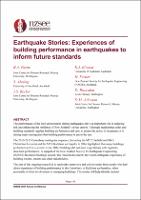| dc.contributor.author | Payne, Benjamin | |
| dc.contributor.author | Abeling, Shannon | |
| dc.contributor.author | Becker, Julia | |
| dc.contributor.author | Elwood, Ken | |
| dc.contributor.author | Ferner, Helen | |
| dc.contributor.author | Brunsdon, Dave | |
| dc.contributor.author | Johnston, David | |
| dc.date.accessioned | 2021-06-22T04:01:51Z | |
| dc.date.available | 2021-06-22T04:01:51Z | |
| dc.date.issued | 2021-04-14 | |
| dc.identifier.uri | https://repo.nzsee.org.nz/xmlui/handle/nzsee/2348 | |
| dc.description.abstract | The performance of the built environment during earthquakes plays an important role in reducing risk and enhancing the resilience of New Zealand’s urban centres. Although engineering codes and building standards regulate building performance and seek to ensure the safety of occupants, it is during major earthquakes that building performance is put to the test.
The 2010-2011 Canterbury earthquake sequence (including the M7.2 Darfield and M6.3 Christchurch events) and the M7.8 Kaikōura earthquake in 2016 highlighted that many buildings performed well in a seismic event. Other buildings did not meet expectations with regard to structural performance. In support of the New Zealand Society for Earthquake Engineering (NZSEE) Resilient Buildings project, this research documents the recent earthquake experience of building owners, tenants and other stakeholders.
The aim of this ongoing research is to undertake interviews and collect stories from people who had direct experience of building performance in the Canterbury or Kaikōura earthquakes, either personally or from involvement in managing buildings. The stories will help identify societal expectations of building performance in the context of recent earthquake experience in New Zealand. The findings will enhance future building performance by informing the refinement of engineering codes and standards through experience-based insight. Initial thematic data is presented in this paper from 16 interviews, which highlight extremely varied perspectives of risk, that new buildings perform beyond a minimum requirement of life-safety, that buildings should repairable, and that an overall goal is to ensure urban centres are functional. | |
| dc.language.iso | en | |
| dc.publisher | New Zealand Society for Earthquake Engineering | |
| dc.relation.ispartofseries | 2021;0089 | |
| dc.subject | Understanding social impacts and improving social resilience | |
| dc.subject | Resilience beyond life-safety and amenity | |
| dc.subject | Society, policy, and culture in understanding impacts and improving resilience | |
| dc.title | Earthquake Stories: Experiences of Building Performance in Earthquakes to enhance future building performance | |
| dc.type | Article | |

